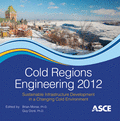Envelope Foundation Employment in Arctic Construction
Publication: Cold Regions Engineering 2012: Sustainable Infrastructure Development in a Changing Cold Environment
Abstract
Envelope foundation type was developed by the Igarka Geocryology Laboratory researchers in the early 1990-ies. Its major features include significant reduction of the soil-foundation interaction areas, and the use of natural ventilation to regulate the thermal regime of the soil bedding. Thick (up to 3-4 m) soil bedding allows the employment of this foundation type in various permafrost conditions. The current technical state of the buildings, employing this foundation type, is generally rather poor. Of 5 such buildings, one is demolished and 4 experience various degree of deformations, after 15-20 years in service. Taking into account the exploitation period of brick-laid buildings and high costs of Arctic construction, research is required to enhance both the construction and exploitation routines of envelope foundations. Case study was carried out in the town of Igarka in the Northern Enisey Region. Regular observations were started here in 2010 to address major reasons of deformations of Igarka Geocryology Laboratory building. These observations include geothermic surveys in 4 boreholes around the building perimeter, wall-mark leveling and snow height surveys. Year-round observation results show that the soil bedding is subject to deep seasonal freezing, but is mostly in the thaw state. Wall-mark leveling revealed that the building is subsiding slowly during the whole year. Subsidence rates vary from 0.3 to 1.5 mm per month. As a result, fissures and cracks appear on both internal and external walls of the building, due to the spandrel deformations. Thus, the major risks for the building stability are attributed to the building subsidence. The patterned frost heave during the beginning of winter adds to the excess stresses on the foundation. Acting in the direction opposite to the overall subsidence, these excess stresses lead to the increased vertical shift tensions. The latter results in the formation of cracks in the walls of the building, but also in the concrete elements of the foundation. The observation results show that envelope foundation is an effective foundation type, suitable for Arctic construction. The design routines, however, should be enhanced in order to prevent potential malfunction of the foundation.
Get full access to this article
View all available purchase options and get full access to this chapter.
Information & Authors
Information
Published In
Copyright
© 2012 American Society of Civil Engineers.
History
Published online: Nov 9, 2012
Authors
Metrics & Citations
Metrics
Citations
Download citation
If you have the appropriate software installed, you can download article citation data to the citation manager of your choice. Simply select your manager software from the list below and click Download.
